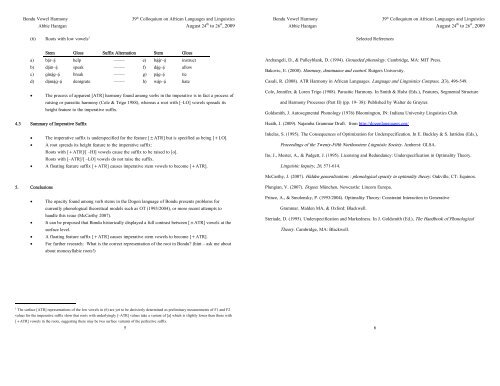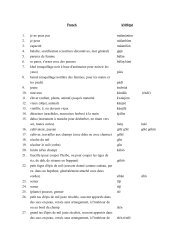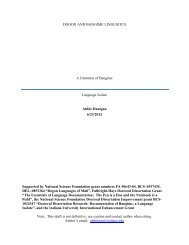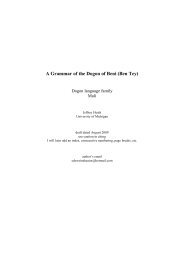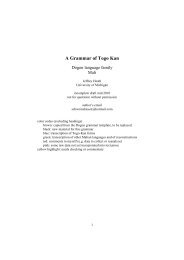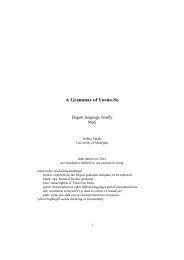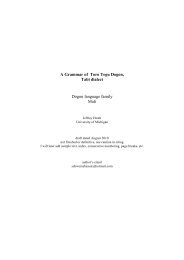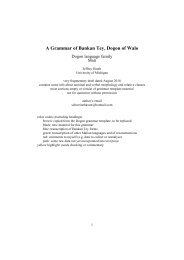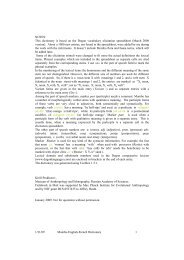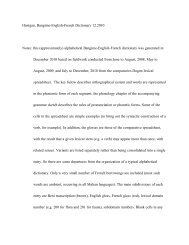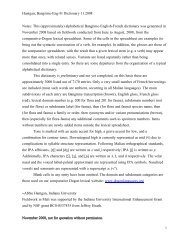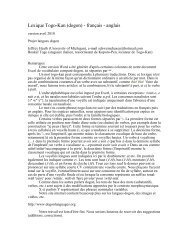Bondu Vowel Harmony - Dogon and Bangime Linguistics
Bondu Vowel Harmony - Dogon and Bangime Linguistics
Bondu Vowel Harmony - Dogon and Bangime Linguistics
- No tags were found...
Create successful ePaper yourself
Turn your PDF publications into a flip-book with our unique Google optimized e-Paper software.
<strong>Bondu</strong> <strong>Vowel</strong> <strong>Harmony</strong> 39 th Colloquium on African Languages <strong>and</strong> <strong>Linguistics</strong>Abbie Hantgan August 24 th to 26 st , 2009(6) Roots with low vowels 3<strong>Bondu</strong> <strong>Vowel</strong> <strong>Harmony</strong> 39 th Colloquium on African Languages <strong>and</strong> <strong>Linguistics</strong>Abbie Hantgan August 24 th to 26 st , 2009Selected ReferencesStem Gloss Suffix Alternation Stem Glossa) ba̘ŕ–á̘ help ––––– e) ba̘á̘ŕ–á̘ instructb) da̘ḿ–á̘ speak ––––– f) dá̘ɡ–á̘ allowc) ɡíná̘ɡ–á̘ break ––––– g) pá̘ɡ–á̘ tied) da̘ḿá̘ɡ–á̘ denigrate ––––– h) wá̘ɲ–á̘ hate• The process of apparent [ATR] harmony found among verbs in the imperative is in fact a process ofraising or parasitic harmony (Cole & Trigo 1988), whereas a root with [–LO] vowels spreads itsheight feature to the imperative suffix.4.3 Summary of Imperative Suffix• The imperative suffix is underspecified for the feature [±ATR] but is specified as being [+LO].• A root spreads its height feature to the imperative suffix:Roots with [+ATR]/[ –HI] vowels cause the suffix to be raised to [o].Roots with [–ATR]/[ –LO] vowels do not raise the suffix.• A floating feature suffix [+ATR] causes imperative stem vowels to become [+ATR].Archangeli, D., & Pulleyblank, D. (1994). Grounded phonology. Cambridge, MA: MIT Press.Bakovic, E. (2000). <strong>Harmony</strong>, dominance <strong>and</strong> control. Rutgers University.Casali, R. (2008). ATR <strong>Harmony</strong> in African Languages. Language <strong>and</strong> <strong>Linguistics</strong> Compass, 2(3), 496-549.Cole, Jennifer, & Loren Trigo (1988). Parasitic <strong>Harmony</strong>. In Smith & Hulst (Eds.), Features, Segmental Structure<strong>and</strong> <strong>Harmony</strong> Processes (Part II) (pp. 19- 38): Published by Walter de Gruyter.Goldsmith, J. Autosegmental Phonology (1976) Bloomington, IN: Indiana University <strong>Linguistics</strong> Club.Heath, J. (2009). Najamba Grammar Draft. from http://dogonlanguages.org/Inkelas, S. (1995). The Consequences of Optimization for Underspecification. In E. Buckley & S. Iatridou (Eds.),Proceedings of the Twenty-Fifth Northeastern Linguistic Society. Amherst: GLSA.Ito, J., Mester, A., & Padgett, J. (1995). Licensing <strong>and</strong> Redundancy: Underspecification in Optimality Theory.Linguistic Inquiry, 26, 571-614.McCarthy, J. (2007). Hidden generalizations : phonological opacity in optimality theory. Oakville, CT: Equinox.5. Conclusions• The opacity found among verb stems in the <strong>Dogon</strong> language of <strong>Bondu</strong> presents problems forcurrently phonological theoretical models such as OT (1993/2004), or more recent attempts toh<strong>and</strong>le this issue (McCarthy 2007).• It can be proposed that <strong>Bondu</strong> historically displayed a full contrast between [±ATR] vowels at thesurface level.• A floating feature suffix [+ATR] causes imperative stem vowels to become [+ATR].• For further research: What is the correct representation of the root in <strong>Bondu</strong>? (hint – ask me aboutabout monosyllabic roots!)Plungian, V. (2007). <strong>Dogon</strong>. München, Newcastle: Lincom Europa.Prince, A., & Smolensky, P. (1993/2004). Optimality Theory: Constraint Interaction in GenerativeGrammar. Malden MA, & Oxford: Blackwell.Steriade, D. (1995). Underspecification <strong>and</strong> Markedness. In J. Goldsmith (Ed.), The H<strong>and</strong>book of PhonologicalTheory. Cambridge, MA: Blackwell.3The surface [ATR] representations of the low vowels in (6) are yet to be decisively determined as preliminary measurements of F1 <strong>and</strong> F2values for the imperative suffix show that roots with underlyingly [–ATR] values take a variant of [a] which is slightly lower than those with[+ATR] vowels in the roots, suggesting there may be two surface variants of the perfective suffix.56


